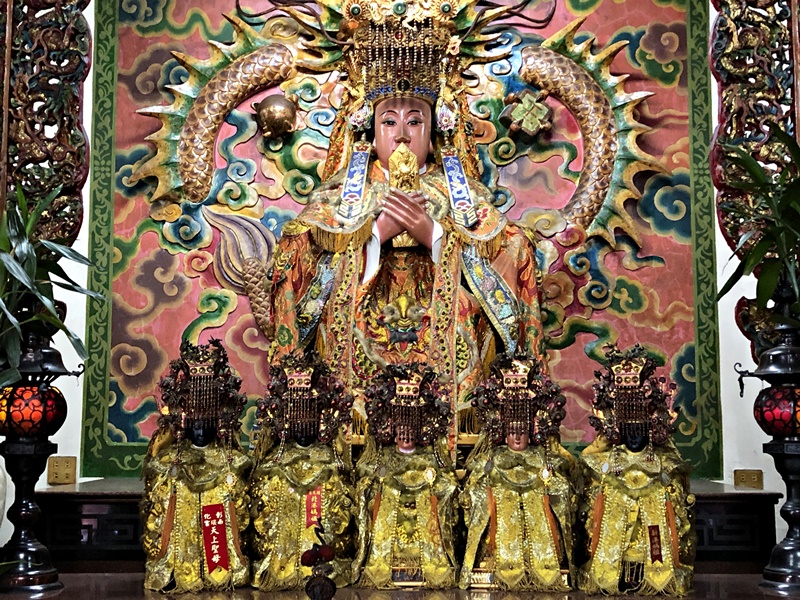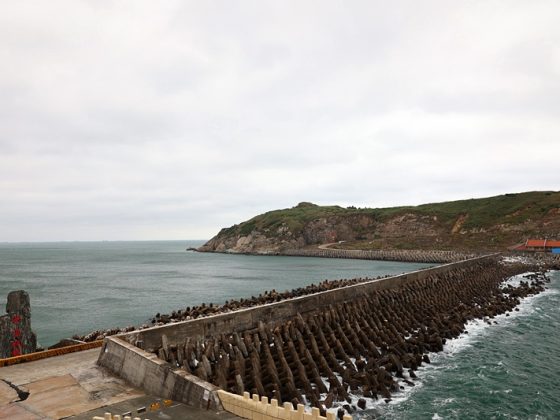This Foreigner’s Long Relationship with Mazu
The Mother Goddess of Taiwan
Author & Photographer / Rick Charette
Though a Canadian raised in a Christian household, the Chinese goddess Mazu (媽祖) has been an intimate part of my adult life, almost all lived in Taiwan. Commonly known as the Goddess of the Sea, she is Taiwan’s most beloved deity, with over 800 temples dedicated to her on Taiwan’s main island and offshore islands. Mazu beliefs and customs have been formally entered in the UNESCO Representative List of the Intangible Cultural Heritage of Humanity.
Before I explain my special relationship with her, let me help you get to know her a little better.
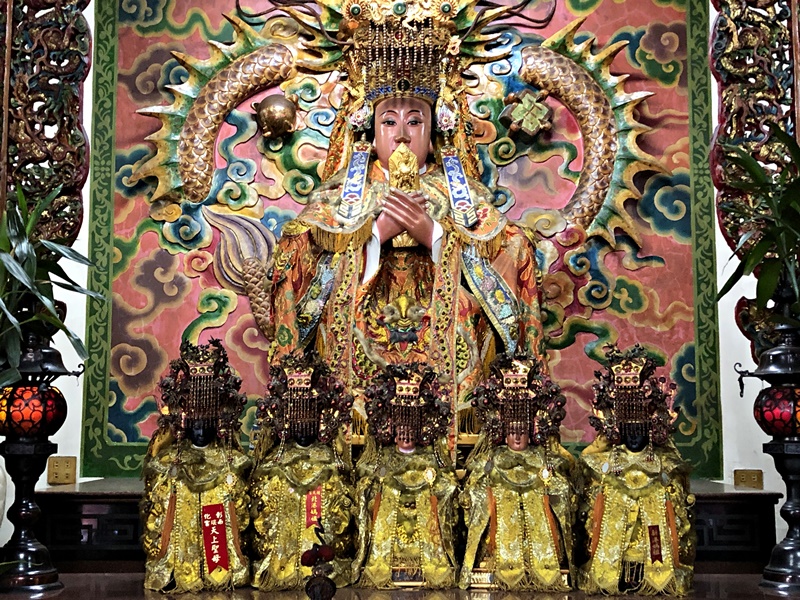
Protecting a People, Past and Present
Mazu worship is concentrated along China’s southeast coast, in Taiwan, and amongst the Chinese diaspora of Southeast Asia. According to legend, back in the late 10th century a mortal lass living along China’s southeast coast, named Lin Mo-niang (林默娘), went into a trance and magically saved seafaring male family members who’d been caught out at sea in a storm. Soon thereafter she ascended to heaven, becoming an immortal. (There are many legend variations; learn more in the “Mazu” Wikipedia entry.)
Word spread, mariner folk began claiming they too had seen her and been saved from troubles at sea, and people began referring to Lin as Mazu, or Mother/Maternal Ancestor. Chinese began emigrating to Taiwan in large numbers starting in the early 1600s, primarily from the coastal areas of Fujian province and northeast Guangdong province directly across from the island. Many brought Mazu icons on their passage for protection during the treacherous voyage across the shallow, oft stormy-tempered Taiwan Strait, and erected temples to her in gratitude for safe crossing in their new homeland.
Over the centuries, fishing and shipping have been intrinsic to Taiwan life, but this benevolent and powerful goddess is approached by the faithful for help in a broad range of affairs far removed from Taiwan’s surrounding watery world. Mazu temples are among the island’s busiest. A truism here is that the blacker the interior of a temple, the more powerful and efficacious the deity enshrined. Why? It is incense smoke that darkens the innards, and more answered prayers equals wider renown, ever more/visitors with prayers, and ever more smoke.
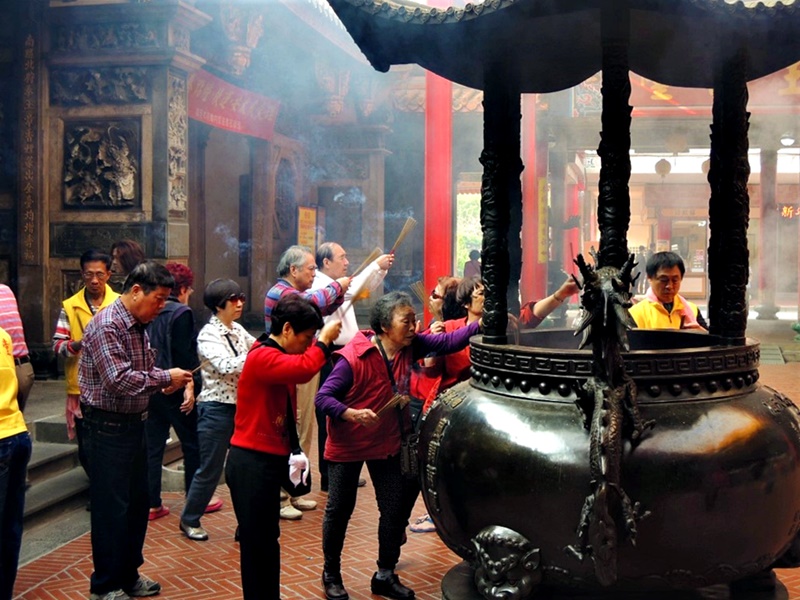
Mazu Hits the Road – Annual Birthday Pilgrimages
Way back when, exactly one month after making landfall (by plane) on Taiwan, I met my future bride, a comely lass from New Taipei City’s Banqiao District. After wedding five years later, we set up house just a 90-second stroll from her parents’ place. In between is a moderately large two-story Mazu temple, the center of our borough’s religious and social life. The builder? My father-in-law, a now-retired apartment building developer, honoring the deathbed wish of a lifelong friend who’d constructed a smaller temple on the site. He is both the temple director and leader of its traditional Chinese-instrument temple band.
I see our neighborhood-protecting Mazu most every day, my wife stopping to briefly bai-bai (offer a prayer; 拜拜) on the way to/from family visits. If my parents-in-law are not at home, they’re almost invariably found in the temple plaza, chatting with borough neighbors. I’ve watched countless Taiwanese operas performed in the plaza for Mazu’s entertainment – staged directly before the open main portal so she can watch – and attended scores of banquets in the next-door hall, celebrating her birthday, capping off the temple’s annual funding drive, etc.
Each year in the period around her birthday, the 23rd day of the third lunar month, Mazu pilgrimages (媽祖遶境進香) launch from Mazu temples around the land, bringing their Mazu icon to visit more powerful – and invariably much older — Mazu temples/icons. The latter are concentrated in the central-south region, where Han Chinese immigration was concentrated in the early modern era. My wife and I participate in our temple’s journey about every second year, organized by my father-in-law, joining 300~350 of our temple-area neighbors.
The ultimate destination on our 3-day peregrination is Chaotian Temple (朝天宮) in Yunlin County’s Beigang town (北港). Our Mazu icon, as for many other temples, was consecrated at the Beigang shrine, its “ancestral temple.” Ashes were taken from the main Chaotian censer to “seed” our temple’s main censer, and with each pilgrimage new ash is brought home. After visiting an icon in a more powerful temple, your icon returns with heightened community-protection powers.
On our slow palanquin procession up to the temple’s open main portal, Chaotian’s Mazu viewing the approach, our elaborately colorful “Eight Generals” (八家將) troupe is in front, clearing evil from our icon’s path. As with other temples, our troupe is filled with young folk from troubled homes, giving them focus and spending money.
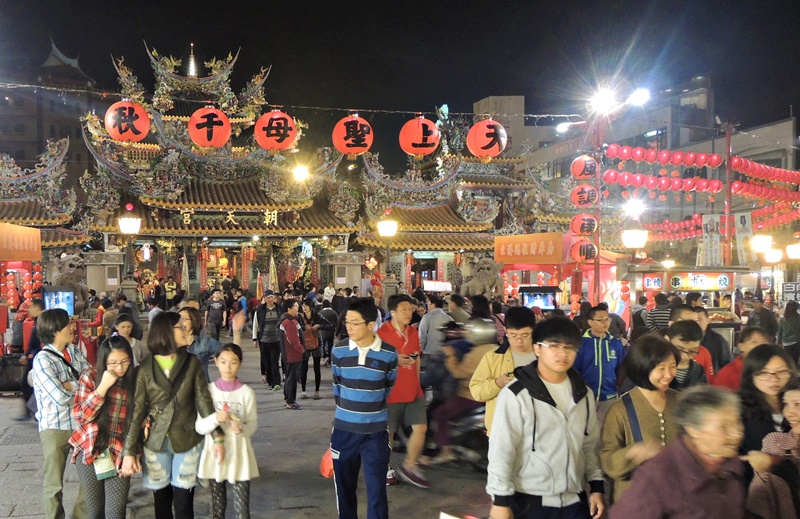
Our palanquin begins to shake forcefully as temple entry nears. The bearers do not do this. No, it is our Mazu that is “excited” at the visit — our bearers steady the palanquin. Stepping through wave upon pounding wave of blasting firecrackers unharmed shows that the Chaotian goddess beholds them with favor. Just before reaching the main portal, our palanquin will suddenly move forward a few steps and then back away a number of times. What is happening is a show of respect, our icon hesitant to enter at the sight of the illustrious deity within – in effect bowing to demonstrate humility and obeisance. After our icon is taken out of her palanquin, passed over the main censer (the smoke providing a blessing), and placed on the main altar for her visit, the hundreds of pilgrims walking in the procession train behind – including yours truly — stream into the temple to pray.
Our band members set up in front of or inside the temples we visit, entertaining our host icon and receiving special blessings in return. Most of our band members are lifelong friends of my brother-in-law, the new leader, my father-in-law now retiring from this duty.
In most temples you’ll the main Mazu icon flanked by two demon guardian generals. These are “Thousand Mile Eyes” (Qianli Yan; 千里眼) and “With-the-Wind Ears” (Shunfeng Er; 順風耳). The former generally has a red body and two horns, the latter a green body with one horn.
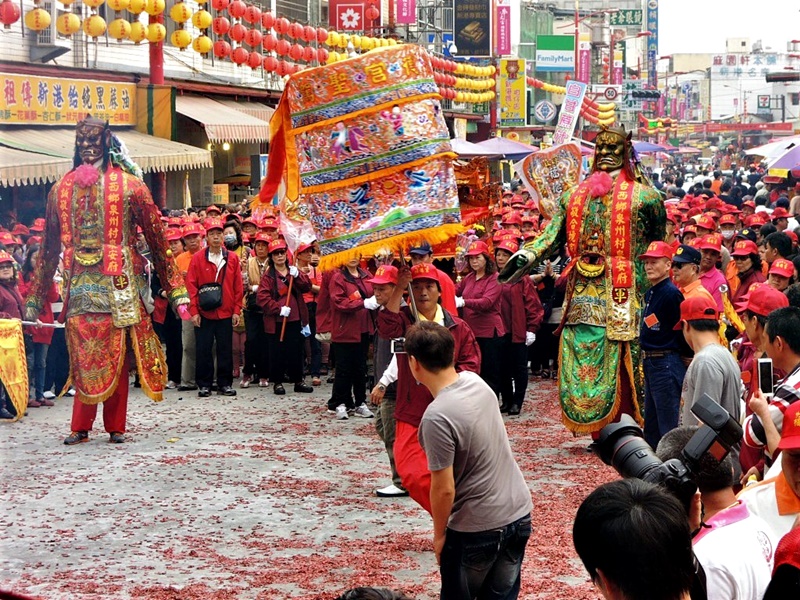
The Dajia Mazu Pilgrimage
Taiwan’s most spectacular Mazu birthday celebration is the long march bringing the Dajia Mazu (大甲媽祖) from Zhenlan Temple (鎮瀾宮) in Taichung City to visit the Mazu at Fengtian Temple (奉天宮) in the rural town of Xingang (新港), Chiayi County. The nine-day, eight-night round-trip journey is over 300 kilometers, with about 100 temples visited and thereby blessed on the way. This is Taiwan’s largest Mazu pilgrimage, with the greatest number of participating performance troupes and pilgrim marchers. Discovery Channel has declared it one of the world’s three biggest religious festivals.
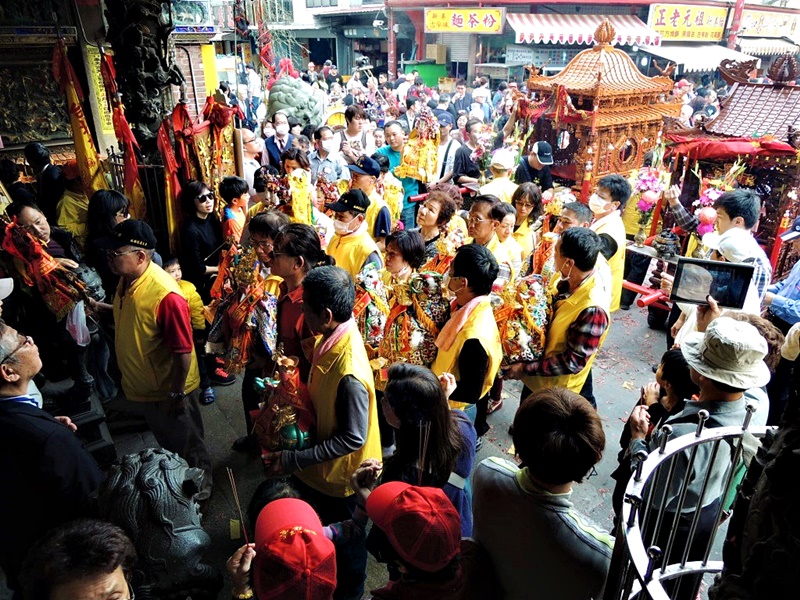
The spiritual sojourn is made to “burn incense” (jinxiang; 進香) at the higher-ranking Fengtian Temple and to “reap the flame” (刈火), i.e., take away ashes from the latter’s main censer to bring home, thus reinvigorating the Dajia icon’s powers. The Fengtian figure, believed to be about 1000 years old, is higher up the icon-pecking order and thus more powerful. The Dajia icon also has remarkable powers; believers crowd the procession route to receive ashes from her censer in auspicious red-dyed pouches as well as some of the tea brewed in offerings to her, both believed to have magical curative powers. All marchers are blessed, and many claim only a completed round-trip journey brings her full protective powers.
Key Mazu Temples to Visit
・Chaotian Temple (北港朝天宮)
Founded in 1694, this is perhaps Taiwan’s most famous Mazu temple. As mentioned above, it’s located in the town of Beigang, Yunlin County. “Beigang” literally means “north port”; silting spelled its demise as a maritime-trading riverport. This was originally the ancestral temple for the Dajia Mazu icon, and the ultimate destination in its annual pilgrimage, but in 1987 a new icon was obtained in China from Chaotian Temple’s own ancestral temple, and a dispute broke out about whose icon had higher ranking and authority. The pilgrimage switch was made to Fengtian Temple the next year.
・Fengtian Temple(新港奉天宮)
As stated earlier, this is in the town of Xingang, a few kilometers southeast of Beigang. The town was founded in 1799 by people displaced from Beigang after major flooding that year. Though “Xingang” means “new port,” there was never a port here. Fengtian Temple was established in 1811 to house the main Mazu icon and other relics saved from the residents’ Beigang Mazu temple, which had been completely destroyed.
・Great Queen of Heaven Temple (大天后宮)
This structure, in Tainan City, was originally a palace, built in 1664 for the last pretender to the Ming Dynasty throne after China fell to the invading Manchu. In 1683 the Manchu took Taiwan, and the victorious admiral used the palace as his headquarters. In 1684 it was converted into a temple. You’ll see “Queen of Heaven” – pinyin spelling “Tianhou” – used in many Mazu temples. This was a title officially bestowed on her by the Manchu, i.e. an official “promotion,” seeking to curry favor with the restless Han Chinese populace. This was the very first temple to use her new title.
・Songshan Ciyou Temple (松山慈祐宮)
Located in Taipei’s Songshan District, construction was launched on this temple in 1753 and completed in 1757. Han Chinese settlement in the Taipei Basin began in the early 1700s. The temple was the cradle for development for today’s Songshan area, which originally flourished as a riverport on the Keelung River. The official story of origin is that a wandering monk, carrying a gilded Mazu statue, met a group of Mazu devotees here, and together they spent 10 years raising money to build the temple.

